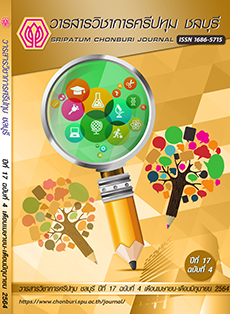COMPARATIVE STUDY OF THE ACCURACY AND PRECISION OF WEATHER TEMPERATURE SENSOR FOR IOT IN DIFFERENT ENVIRONMENT
Keywords:
accuracy, precision, weather temperature sensor, IoTAbstract
This research was focused to comparative study of the accuracy and precision of weather temperature sensors for IoT in different environment. The research method used 8 types of sensor devices included DHT11, DHT12, DHT21/AM2301, DHT22, DHT22/AM2302, DS3231, LM35, MLX90614 to test by using with the board NodeMCU ESP8266 and programming in C language to find the results. Testing in different environment between closed area, choose to use the server room of Sripatum University Chonburi Campus and open room, that the results obtained from the test temperature measurement of each sensor in server room will be compared with the thermometer inside the server room. The temperature measurement in the open room will be compared with the Hetaida thermometers model HTD8808E to compare the accuracy of the temperature sensing of the sensors to be tested. The results of the research showed that temperature detection in closed room area was server room of Sripatum University Chonburi Campus. The DHT11 sensor was found to detect temperatures more accurately than others, with an accuracy of 98.11% and had a discrepancy value of 0.4 °C, and that of the temperature detection test in the open area. It was found that there are two types of sensors that detect temperatures more accurately and precision than other types: DHT11 and DS3231, with an accuracy of 98.22% and had a discrepancy value of 0.5 °C. And the results obtained from the research can be concluded that temperature sensor devices that provide accuracy and precision when it comes to detecting temperatures in different environments can still detect the same accurate temperature.
References
ประภาพร กุลลิ้มรัตน์ชัย. (2559). Internet of things: แนวโน้มเทคโนโลยีปัจจุบันกับการใช้งานในอนาคต. วารสารวิชาการมหาวิทยาลัยอีสเทิร์นเอเชีย ฉบับวิทยาศาสตร์และเทคโนโลยี, 10(1), หน้า 29-36.
ปรีชา กอเจริญ และคณะ. (2560). เทคโนโลยีการสื่อสารไร้สายสำหรับอินเทอร์เน็ตของสรรพสิ่ง. วารสารวิชาการ กสทช., 2(ประจำปี 2560), หน้า 268-287.
วิวัฒน์ มีสุวรรณ์. (2559). อินเทอร์เน็ตเพื่อสรรพสิ่ง (internet of things) กับการศึกษา. วารสารวิชาการนวัตกรรมสื่อสารสังคม, 4(2), หน้า 83-92.
สำนักงานคณะกรรมการนโยบายวิทยาศาสตร์เทคโนโลยีและนวัตกรรมแห่งชาติ. (2559). Horizon 20-Welcome to the unobservable world-sensor technology. กรุงเทพฯ: เปนไทพับลิชชิ่ง.
Dangi, Nagendra. (2017). Monitoring environmental parameters: Humidity and temperature using Arduino based microcontroller and sensors (Online). Available: https://www.theseus.fi/bitstream/handle/10024/142235/Dangi_Nagendra.pdf?sequ [2020, November 22].
Manches, Andrew, et al. (2015). Three questions about the internet of things and children. TechTrends, 59, pp. 76-83.
Srivastava, Deeksha, Kesarwani, Awanish, & Dubey, Shivani. (2018). Measurement of temperature and humidity by using Arduino tool and DHT11. International Research Journal of Engineering and Technology (IRJET), 5(12), pp. 876-878.
Vallabh, Brajesh, et al. (2021). Data acquisition technique for temperature measurement through DHT11 sensor (Online). Available: https://link.springer.com/chapter/10.1007/978-981-15-6707-0_53 [2020, November 22].
Downloads
Published
Issue
Section
License
บทความทุกบทความเป็นลิขสิทธิ์ของวารสารวิชาการศรีปทุม ชลบุรี



